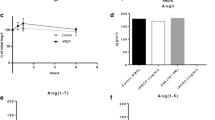Abstract
Hyperhomocyst(e)inemia has been associated with the development of hypertension, stroke, and cardiovascular, cerebral/neuronal, renal, and liver diseases. To test the hypothesis that homocyst(e)ine plays an integrated role in multiorgan injury in hypertension, we employed: (1) spontaneously hypertensive rats (SHR) in which endogenous homocyst(e)ine levels are moderately high (18.1 ± 0.5 μM); (2) control age- and sex-matched Wistar Kyoto (WKY) rats in which homocyst(e)ine levels are normal (3.7 ± 0.3 μM). To create the pathophysiological condition of hyperhomocyst(e)inemia, 20 mg/day homocyst(e)ine was administered for 12 weeks in (3) SHR (SHR-H) and in (4) WKY (WKY-H) rats. (5) Endogenous homocyst(e)ine levels were reduced slightly but not significantly from 18.1 ± 0.5 μM to 12.5 ± 0.7 μM in SHR by folic acid administration (SHR-F). Plasma and tissue levels of homocyst(e)ine were determined by HPLC and spectrophotometric methods. Plasma and sympathetic ganglion (neuronal) matrix metalloproteinase (MMP) activity was measured by zymography. Activity of neuronal MMP was increased in hyperhomocyst(e)inemic rats as compared with controls. Mean arterial pressure (mmHg) was 95 ± 5, 126 ± 8, 157 ± 10, 188 ± 5, and 165 ± 12 in WKY, WKY-H, SHR, SHR-H, and SHR-F, respectively. Urinary protein (mg/day) was 0.11 ± 0.03, 0.88 ± 0.22, 0.47 ± 0.10, 0.89 ± 0.21, and 0.81 ± 0.21 in WKY, WKY-H, SHR, SHR-H, and SHR-F, respectively, as measured by the Bio-Rad dye binding assay. The relationships between increased arterial pressure, plasma homocyst(e)ine, and urinary protein were delineated. Plasma and neuronal creatinine phosphokinase (CK) isoenzymes were measured by agarose gel electrophoresis. All three CK isoenzymes, i.e., MM, MB, and BB, specific for skeletal, cardiac, and nerve tissue, respectively, were induced following 12 weeks' hyperhomocyst(e)inemia, suggesting multiorgan injury by homocyst(e)ine. Homocyst(e)ine induces endocardial endothelial cell (capillary) apoptosis and may reduce capillary cell density. Structural damage to aorta, myocardium, kidney, and renal-ureter was analyzed by histology. Results suggested an integrated physiological role of homocyst(e)ine in injury to the endothelial/epithelial cell lining in the respective organs.
Similar content being viewed by others
Author information
Authors and Affiliations
Additional information
Received: June 16, 2000 / Accepted: September 30, 2000
Rights and permissions
About this article
Cite this article
Miller, A., Mujumdar, V., Shek, E. et al. Hyperhomocyst(e)inemia induces multiorgan damage. Heart Vessels 15, 135–143 (2000). https://doi.org/10.1007/s003800070030
Issue Date:
DOI: https://doi.org/10.1007/s003800070030




